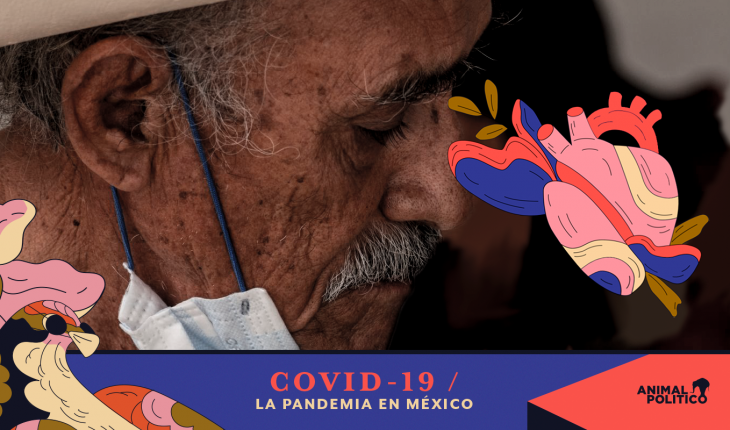Hypertension, obesity and diabetes are some of the comorities that explain why Mexico exceeded 200,000 coVID-19 deaths and has one of the highest rates of deaths per 100,000 inhabitants in Latin America (one thousand 203, second only to Peru and Panama).
However, there are conditions that have gone unnoticed, such as chronic kidney damage. According to an analysis of open data from the Directorate-General for Epidemiology, kidney problems are one of the deadliest conditions in case of coronavirus disease.
The combination of age over 60, immunosuppression and chronic kidney problems is the deadliest in case of COVID-19: 61% of the people who combined these conditions ended up dying.
An analysis conducted using the latin American Center for Journalistic Research (CLIP) data team shows that chronic kidney problems were present in 19 of the 20 deadliest cases linked to coronavirus. To carry out the analysis, all cases reported as contagion until 1 February that were confirmed as Sars-Cov2 and with the factors also confirmed were taken into account.
Factors analyzed include obesity, hypertension, diabetes, obesity, immunosuppression, heart disease, or chronic obstructive pulmonary disease (COPD).
Overall, the analysis notes that 41% of COVID-19 patients who also suffered from chronic kidney problems died. Fatal outcome also occurred with 36% of COPD patients, 29.5% of those with heart problems, 25.7% affected by diabetes and 24% with immunosuppression or hypertension.
70% of the dead with some precondition
The director general of the National Center for Preventive Programs and Disease Control, Ruy López Ridaura, explained at the evening conference on the advancement of the pandemic that 70% of the deceased had some comorability, 40% suffered from at least two and 15% suffered three or more.
The health count states that 45% of the deceased had hypertension, 37% diabetes, 21.9% obesity, 7.6% smoking, 6.7% chronic kidney failure and 5% heart problems.
What’s relevant here is how widespread the comorability was before the pandemic. That’s why diabetes and hypertension are so important because they have a higher prevalence among Mexicans than other diseases that, despite being more lethal in combination with COVID-19, affect fewer people.
According to the CLIP analysis, 18% of the infected suffered from hypertension and 14% diabetes, 320 thousand and 250 thousand people, respectively. In contrast, the rest of previous diseases have a much lower impact: 2% chronic kidney problems, 1% COPD, 2% cardiovascular disease and 1% immunosuppression. That is, comorities with greater lethality such as kidney damage affected fewer people.
“In Mexico, comorities weighed greatly, especially in people between the ages of 40 and 60. The lethality of the disease in patients over 60 years of age is very high worldwide, but in Mexico it was higher at these intermediate ages. To this extent it can be explained by the large number of people who have chronic noncommunicable diseases,” says Juan Rivera Dommarco, director general of the National Institute of Public Health.
Mexico initiated the COVID-19 pandemic in worse conditions than other countries in the region to cope. It is at the forefront of Latin America in obesity and overweight, with about 70% of the population, with high rates of hypertension (about 20%) diabetes (15%).
High prevalence is compounded by the low control of diseases. According to Miguel Malo, WHO’s phD on chronic diseases, of all patients with hypertension or diabetes, only half know that he suffers from this disease. Of those diagnosed, only half receive treatment. And whoever’s being medicated, only half of them have the disease under control.
The deadliest factors
Now, more than a year after the start of the pandemic, analysis of the Ministry of Health’s open database shows the most lethal factors.
A man over the age of 60 with immunodeficiency and kidney problems is the deadliest combination when contracting COVID-19, with 61% lethality.
Behind him, a man over the age of 60, obese and with chronic kidney disease (58.7% lethality), a man over the age of 60, with COPD, who continues to smoke and suffers from the kidney (57.9% lethality), a man over sixty years of age con COPD and chronic kidney problems (57.3%) and a man over the age of 60, with diabetes and chronic kidney disease (57.3%).
These combinations, however, affect a very small percentage of COVID-19 patients. That’s why we talk more about hypertension, obesity and diabetes as big triggers for mortality in Mexico. “There is a pandemic of chronic noncommunicable diseases, especially obesity and overweight, with much higher rates than in other countries,” says Dr Miguel Malo.
Bad notes that when the pandemic begins there was no certainty about what factors can aggravate the condition of coronavirus patients. “He got to know each other on the fly, at first it wasn’t known,” he says.
In Mexico some of the first measures of the health alert were to try to protect the vulnerable population (older adults, chronically ill, pregnant women). At this point the question is obligatory: could the Mexican government do anything else to protect the population with greater risks?
When it comes to explaining why these high mortality figures are recorded, experts talk about two aspects. On the one hand, the poor health of the Mexican population. On the other hand, the economic conditions that forced the population to go out to work and not comply with protective measures.
On the state of health, Dr. Miguel Malo argues that this is an inherited problem over the past few decades. And it points to the causes: smoking, harmful use of alcohol, poor diet and sedentary lifestyles. In other words, little could be done in terms of public health to reverse a bad situation that has been dragging on for years. Going forward, the WHO expert does value legislative initiatives such as food labelling that warns of excess calories, fats or sodium.
“Mexico advanced something, but more can still be done. However, there are powerful economic interests and lobbyists to prevent laws from passing,” Malo says.
Poverty also has a significant impact on mortality. Political Animal has already documented that the poorest were the hardest hit by the pandemic. “In general, there was a lack of greater support for vulnerable people to mitigate the economic effects of the pandemic and allow the pandemic to follow recommendations to stay home. It is good that there are money transfers for the most vulnerable groups, but they are insufficient. It should have perhaps expanded the standard and increased the amounts,” says Rivera Dommarco.
In the end, the recommendation to stay home was a privilege that only a few were able to access. In the private sector, there were multiple complaints about being forced to go to their jobs despite health recommendations. Those working in the informal sector had no choice but to go out to work.
Barely a year has passed since the pandemic reached Mexico so there are still many elements that need to be studied. In the opinion of Malaquías López, professor of public health at UNAM, there are other factors such as lack of training in hospitals and the dissused medicines.
The figures show that there is a link between certain previous factors and higher mortality. How changing the health of the population overnight is impossible, we will have to see what happens in the future. The government has set its strategy to limit children’s access to junk food and sugary drinks. However, there is data that does not allow us to be optimistic.
On the one hand, there is the effect of hospital conversion on those who already have a disease such as diabetes or hypertension. “There are people who interrupted treatment, or who required surgeries or diagnostic studies that were not performed, we need to study how this can have an impact on deaths from chronic diseases,” says Rivera Dommarco.
On the other hand, the pandemic itself has favored more sedentary lifestyles. A recent study indicates that Mexicans gain an average of 8.5 kilos during this year of confinement.
With more precarious medical services and weakened health, the factors that increase mortality among COVID-19 patients are expected to continue to increase.
What we do at Animal Politics requires professional journalists, teamwork, dialogue with readers and something very important: independence. You can help us keep going. Be part of the team.
Subscribe to Animal Politics, receive benefits and support free journalism.#YoSoyAnimal
translated from Spanish: Being over 60 and with kidney disease: lethal combination with COVID
April 8, 2021 |





